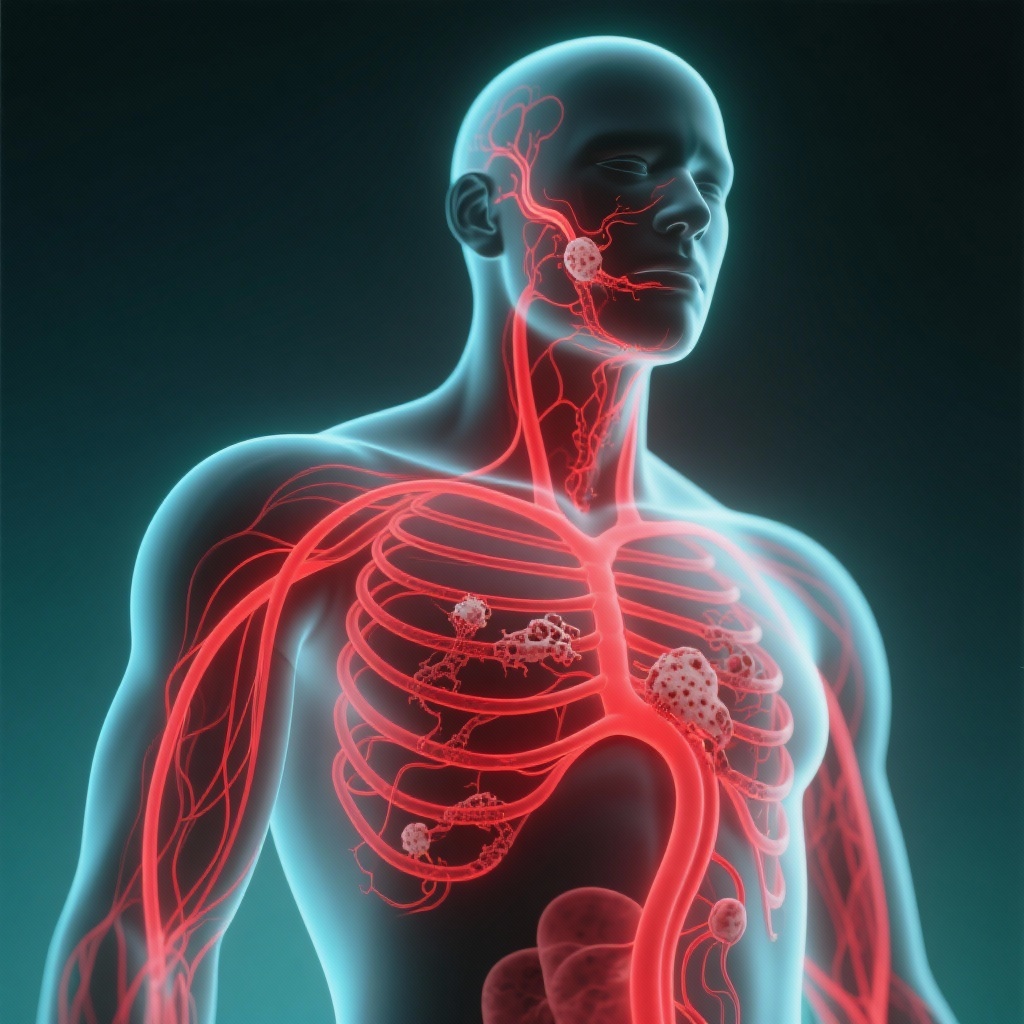Deeply Unpacking the Mystery of Blood Stasis
Blood Stasis describes a key concept in Traditional Chinese Medicine (TCM). It highlights poor blood circulation throughout the body. Specifically, it refers to a pathological state where blood flow becomes sluggish or stagnant locally. Imagine your body’s intricate blood vessels as a sophisticated city plumbing system. In this analogy, Blood Stasis is similar to a stubborn “clog” or “silt buildup” within those vital pipes. This blockage prevents blood from reaching all necessary organs and tissues effectively.

Recognize the Signals: Spotting Blood Stasis Symptoms
The most classic symptom associated with Blood Stasis is persistent pain. This pain typically has a fixed location, a hallmark known as “pain with a fixed spot.” People often describe it as sharp, stabbing, or intense cramping. Beyond pain, other signs emerge on the body’s surface. You might notice a dull complexion or lips that appear purplish. A significant indicator is a dark or purple tongue, sometimes with visible spots. Skin can feel rough, and bruising may occur easily. Women often report severe menstrual cramps and dark blood with clots. These symptoms indicate poor circulation and underlying blood flow issues.
Uncover the Causes: Why Blood Flow Gets Stuck
Multiple factors can contribute to the development of Blood Stasis over time. Physical injuries, for instance, can directly damage local blood vessels. Emotional upset or prolonged stress might cause “Qi Stagnation,” like a traffic jam in your body. This internal congestion can then lead to stagnant blood and impaired flow. Exposure to cold can constrict blood vessels, further hindering proper circulation. Chronic illnesses may also weaken the body’s vital energy, reducing its pumping power. Modern lifestyles, including prolonged sitting, contribute significantly to these issues. Diets high in unhealthy fats and regular smoking are also common culprits. These factors collectively contribute to various circulatory blockages and related problems. For a deeper dive into these foundational concepts, explore our TCM Basics: Qi & Blood section.
Understand Your Pain: The Root of Blood Stasis Discomfort
A fundamental principle in Traditional Chinese Medicine states: “Where there is no free flow, there is pain.” This ancient wisdom perfectly explains the mechanism of pain in Blood Stasis. When blood flow becomes restricted, vital organs and tissues receive insufficient nutrients. Simultaneously, metabolic waste products start to accumulate, unable to clear efficiently. This harmful buildup directly triggers localized discomfort and persistent pain. Think of it like a garden hose becoming blocked; without water, the plants will inevitably wilt. The body’s intricate systems suffer similar consequences from blood flow issues.
Protect Your Heart: How Blood Stasis Impacts Your System
Blood Stasis has far-reaching effects beyond just local discomfort and pain. It significantly impacts the entire cardiovascular and circulatory system. Your heart must work much harder, pumping forcefully to overcome increased resistance. This extra effort places considerable and unhealthy strain on your heart. Persisting vascular congestion can unfortunately contribute to chronic health problems. It may increase risks for conditions like high blood pressure, a common modern ailment. Coronary heart disease and cerebrovascular diseases are also potential long-term outcomes. Therefore, addressing this underlying issue is crucial for overall health. (PMID: 28873738)

Clear the Path: Effective Blood Stasis Treatments
The fundamental approach to treating Blood Stasis is “activating blood and dispelling stagnation.” This involves restoring smooth flow and clearing away blockages in the body. Traditional Chinese Medicine often utilizes specific herbs for this purpose. Ingredients like Salvia (Danshen), Safflower (Honghua), and Ligusticum (Chuanxiong) are commonly prescribed. These herbal remedies function much like powerful “clearing agents” for your circulatory system. They actively work to dissolve and eliminate unwanted accumulations within blood vessels. Acupuncture offers another effective path for addressing circulatory blockage. Practitioners select specific points such as Xuehai, Geshu, and Sanyinjiao to stimulate. Targeted needle stimulation at these key Acupoints & Meridians promotes improved blood flow issues.
Empower Your Health: Daily Habits for Preventing Stagnation
Preventing and managing Blood Stasis involves adopting some simple daily habits. Regular, moderate exercise is crucial for actively promoting healthy blood circulation. Make it a point to avoid prolonged periods of sitting or inactivity throughout your day. Your diet also plays a vital role in supporting optimal blood flow. Incorporate foods known for their “blood-activating” properties into your meals. Hawthorn berries, black fungus, and onions are excellent examples of such choices. For more specific recommendations, visit our Nourishing Blood section. Maintaining a positive emotional state is equally important for circulation. Try to manage stress and avoid prolonged feelings of sadness or depression. These holistic strategies enhance your body’s natural ability to prevent cellular waste buildup. (PMID: 32066840)
Indeed, Blood Stasis often underlies numerous chronic pain conditions. It also contributes significantly to various circulatory system diseases. Therefore, recognizing the signs early is incredibly important for your well-being. Prompt and appropriate treatment is absolutely crucial for maintaining long-term health. Don’t let these painful blockages compromise your vitality and comfort. (PMID: 35029013)
Your 3-Second Blood Stasis Self-Check + 30-Second Self-Rescue
- If your tongue is dark, purplish, or has visible spots, immediately try pressing the Sanyinjiao acupoint (three finger-widths above your inner ankle bone) firmly for 30 seconds on each leg.
- If you frequently experience sharp, fixed pain that doesn’t move around, immediately consider making a warm hawthorn berry tea to gently promote blood circulation.
- If you notice easy bruising without a clear injury, immediately commit to a 30-minute brisk walk daily to encourage consistent, healthy blood flow throughout your body.
References
[1] Research indicates that chronic systemic blood stasis can contribute to cardiovascular strain and increased risk for conditions like hypertension. (PMID: 28873738)
[2] A balanced diet rich in antioxidant-rich foods and regular physical activity are recognized as key lifestyle interventions for promoting vascular health. (PMID: 32066840)
[3] Integrating Traditional Chinese Medicine principles, such as addressing blood stasis, offers a comprehensive approach to managing chronic pain conditions and improving overall circulatory health. (PMID: 35029013)
Medical Disclaimer:This article is for educational use only and is not a substitute for professional medical advice.